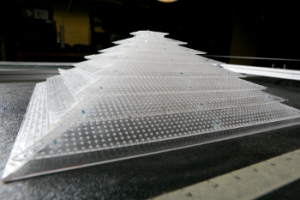Mar 13 2014
Using little more than a few perforated sheets of plastic and a staggering amount of number crunching, Duke engineers have demonstrated the world’s first three-dimensional acoustic cloak. The new device reroutes sound waves to create the impression that both the cloak and anything beneath it are not there.
 A close up view of the 3D acoustic cloak. The geometry of the plastic sheets and placement of the holes interacts with sound waves to make it appear as if it isn’t there.
A close up view of the 3D acoustic cloak. The geometry of the plastic sheets and placement of the holes interacts with sound waves to make it appear as if it isn’t there.
The acoustic cloaking device works in all three dimensions, no matter which direction the sound is coming from or where the observer is located, and holds potential for future applications such as sonar avoidance and architectural acoustics.
The study appears online in Nature Materials.
“The particular trick we’re performing is hiding an object from sound waves,” said Steven Cummer, professor of electrical and computer engineering at Duke University. “By placing this cloak around an object, the sound waves behave like there is nothing more than a flat surface in their path.”
To achieve this new trick, Cummer and his colleagues turned to the developing field of metamaterials—the combination of natural materials in repeating patterns to achieve unnatural properties. In the case of the new acoustic cloak, the materials manipulating the behavior of sound waves are simply plastic and air. Once constructed, the device looks like several plastic plates with a repeating pattern of holes poked through them stacked on top of one another to form a sort of pyramid.
Acoustic Cloak Demonstration
To give the illusion that it isn’t there, the cloak must alter the waves’ trajectory to match what they would look like had they had reflected off a flat surface. Because the sound is not reaching the surface beneath, it is traveling a shorter distance and its speed must be slowed to compensate.
“The structure that we built might look really simple,” said Cummer. “But I promise you that it’s a lot more difficult and interesting than it looks. We put a lot of energy into calculating how sound waves would interact with it. We didn’t come up with this overnight.”
To test the cloaking device, researchers covered a small sphere with the cloak and “pinged” it with short bursts of sound from various angles. Using a microphone, they mapped how the waves responded and produced videos of them traveling through the air.
Cummer and his team then compared the videos to those created with both an unobstructed flat surface and an uncloaked sphere blocking the way. The results clearly show that the cloaking device makes it appear as though the sound waves reflected off an empty surface.
Although the experiment is a simple demonstration showing that the technology is possible and concealing an evil super-genius’ underwater lair is a long ways away, Cummer believes that the technique has several potential commercial applications.
“We conducted our tests in the air, but sound waves behave similarly underwater, so one obvious potential use is sonar avoidance,” said Cummer. “But there’s also the design of auditoriums or concert halls—any space where you need to control the acoustics. If you had to put a beam somewhere for structural reasons that was going to mess up the sound, perhaps you could fix the acoustics by cloaking it.”
This research was supported by Multidisciplinary University Research Initiative grants from the Office of Naval Research (N00014-13-1-0631) and from the Army Research Office (W911NF-09-1-00539).